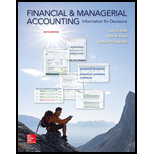
Note Receivable:
It refers to the amount that is to be received by a company from a third party on a promise to pay at any specified future date.
It means record of financial data related to business transactions in a journal in a manner so that debit equals credit. It provides an audit trail to the auditor and a means to analyze the effects of transactions to an organization’s financial health.
Rules of Journal Entry:
The rules for journal entry are defined by 5 accounting components,
► Assets: Increase in asset should be debit and decrease should be credit.
► Liabilities: Increase in liabilities should be credit and decrease should be debit.
► Equity: Increase in Equity should be credit and decrease should be debit.
► Expense: Increase in expense should be debit and decrease should be credit.
► Revenue: Increase in revenue should be credit and decrease should be debit.
To prepare: Adjustment entry to record the given transactions for note receivables.
Want to see the full answer?
Check out a sample textbook solution
Chapter 7 Solutions
Financial and Managerial Accounting: Information for Decisions
- Noyan Carter's weekly gross earnings for the week ending August 15th were $3,200, and his federal income tax withholding was $650. Assuming the Social Security rate is 6.2% and Medicare is 1.5% of all earnings, What is Carter's net pay?arrow_forwardSuppose that Cullumber Automated Retail Company has the following inventory data: Nov. 1 Inventory 23 units @ $4.70 each 8 Purchase 94 units @ $5.05 each 17 Purchase 47 units @ $4.90 each 25 Purchase 70 units @ $5.10 each The company uses a periodic inventory system. A physical count of merchandise inventory on November 30 reveals that there are 78 units on hand. Cost of goods sold under LIFO rounded to the nearest dollar is $386. $396. $784. $774.arrow_forwardOn May 1, Sandhill Company had beginning inventory consisting of 360 units with a unit cost of $8. During May, the company purchased inventory as follows: 720 units at $8 1080 units at $9 The company sold 1800 units during the month for $14 per unit. Sandhill uses the average-cost method. Assuming that a periodic inventory system is used, the value of Sandhill's inventory at May 31 is (Round average cost per unit to 2 decimal places, e.g. 12.52.) ○ $3240 ○ $18360 ○ $3060 ○ $2880arrow_forward
- Suppose that Sandhill Trading Post has the following inventory data: July 1 Beginning inventory 46 units at $23 $1058 7 Purchases 162 units at $24 3888 22 Purchases 23 units at $26 598 $5544 The company uses a periodic inventory system. A physical count of merchandise inventory on July 31 reveals that there are 58 units on hand. Using the LIFO inventory method, the amount allocated to cost of goods sold for July is ○ $4198. ○ $4036. ○ $3932. ○ $4106.arrow_forwardSuppose that Sandhill Trading Post has the following inventory data: July 1 Beginning inventory 46 units at $23 $1058 7 Purchases 162 units at $24 3888 22 Purchases 23 units at $26 598 $5544 The company uses a periodic inventory system. A physical count of merchandise inventory on July 31 reveals that there are 58 units on hand. Using the LIFO inventory method, the amount allocated to cost of goods sold for July is ○ $4198. ○ $4036. ○ $3932. ○ $4106.arrow_forwardSuppose that Ivanhoe Depot Inc. has the following inventory data: July 1 Beginning inventory 24 units at $19 $456 7 Purchases 84 units at $20 1680 22 Purchases 12 units at $22 264 $2400 The company uses a periodic inventory system. A physical count of merchandise inventory on July 31 reveals that there are 40 units on hand. Using the FIFO inventory method, the amount allocated to ending inventory for July is ○ $824. 000 $800. ○ $880. ○ $776.arrow_forward

 AccountingAccountingISBN:9781337272094Author:WARREN, Carl S., Reeve, James M., Duchac, Jonathan E.Publisher:Cengage Learning,
AccountingAccountingISBN:9781337272094Author:WARREN, Carl S., Reeve, James M., Duchac, Jonathan E.Publisher:Cengage Learning, Accounting Information SystemsAccountingISBN:9781337619202Author:Hall, James A.Publisher:Cengage Learning,
Accounting Information SystemsAccountingISBN:9781337619202Author:Hall, James A.Publisher:Cengage Learning, Horngren's Cost Accounting: A Managerial Emphasis...AccountingISBN:9780134475585Author:Srikant M. Datar, Madhav V. RajanPublisher:PEARSON
Horngren's Cost Accounting: A Managerial Emphasis...AccountingISBN:9780134475585Author:Srikant M. Datar, Madhav V. RajanPublisher:PEARSON Intermediate AccountingAccountingISBN:9781259722660Author:J. David Spiceland, Mark W. Nelson, Wayne M ThomasPublisher:McGraw-Hill Education
Intermediate AccountingAccountingISBN:9781259722660Author:J. David Spiceland, Mark W. Nelson, Wayne M ThomasPublisher:McGraw-Hill Education Financial and Managerial AccountingAccountingISBN:9781259726705Author:John J Wild, Ken W. Shaw, Barbara Chiappetta Fundamental Accounting PrinciplesPublisher:McGraw-Hill Education
Financial and Managerial AccountingAccountingISBN:9781259726705Author:John J Wild, Ken W. Shaw, Barbara Chiappetta Fundamental Accounting PrinciplesPublisher:McGraw-Hill Education





